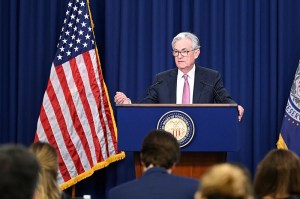Latest Interest Rate Hike Points to Mixed Impact for CRE
Analysts weigh in on the Federal Reserve’s biggest increase in two decades.

Federal Reserve chair Jerome Powell addresses press conference following FOMC meeting May 4. Photo courtesy of the Federal Reserve via Flickr
The Federal Reserve is a long way from done with raising interest rates, and the impact on the economy as well as on commercial real estate may unfold throughout the year.
That was the initial feedback from analysts as the commercial real estate industry took stock of the central bank’s second hike in less than two months. On Wednesday, the Federal Open Market Committee (FOMC) voted for the first 50-basis-point increase since 2000. The step marks the Fed’s latest bid to fight inflation and follows the 25-basis-point hike announced on March 16.
Some leading commercial real estate economists say that the rate hikes will not have a major immediate effect on the health of the industry, despite the possibility of dampening economic growth in general.
“Outside of the office sector, which is lagging behind as employers allow increased remote work flexibility to keep and attract talent, commercial real estate continues to strengthen,” said Lawrence Yun, chief economist at the National Association of Realtors.
“The industrial sector is booming, retail is turning positive, the hotel industry is recovering, apartments are doing very well, and rents are rising in all commercial sectors,” Yun added, speaking Wednesday at NAR’s Commercial Economic Issues and Trends Forum in National Harbor, Md. Industrial rents are poised to keep rising during the next two years, and some midsize office markets are showing improvement as occupants seek alternatives to big cities, he predicted.
Risks and silver linings
Nevertheless, rising rates could prove to be a drag on overall economic growth, “which may result in some companies reducing their projections for future office space needs.” That was the assessment of Trepp’s Julianne Cavaliere, writing last week in the firm’s three-part series on interest rates and commercial real estate. “With that in mind, landlords may be more willing to lock in tenants at their current rates rather than risk losing them.”
Rising rates could also spell challenges for office finance. Trepp estimates that refinancing volume for office CMBS could reach $10.3 billion this year.
Despite the prospect of higher financing costs, a silver lining to the projected series of rate hikes is that capital sources will be even more willing to lend, Cavaliere noted: “Ultimately there may be some near-term volatility in 2022 seen across all sectors of CRE, but … higher rates will attract capital later in the year and beyond,” Cavaliere noted.
The Fed also reinforced broad speculation that further hikes are likely in coming months. FOMC is “prepared to adjust the stance of monetary policy as appropriate” if it identifies hurdles to its twin goals of maximum employment and 2 percent inflation,” the Fed said in a statement announcing the increase.
Experts offered various predictions about the extent of those increases. “We are far from done (with rate hikes) at this point,” said Mike Fratantoni, senior vice president & chief economist at the Mortgage Bankers Association. MBA’s forecast is that the Fed Funds rate will reach 2.5 percent—the neutral rate—by the end of this year.
In a research note published Wednesday, ING Group estimates that the the baseline rate will reach 3.25 percent because of inflation that is proving “far stickier than in recent cycles.” Researchers from the financial services company said that they could not rule out a 75 percent basis point increase in June.
“We then expect a further 50-basis-point hike in July before the Bank moves to 25-basis-point increments at the final three meetings of 2022 as quantitative tightening gets up to speed and contributes to the tighter monetary conditions,” the researchers wrote.







You must be logged in to post a comment.